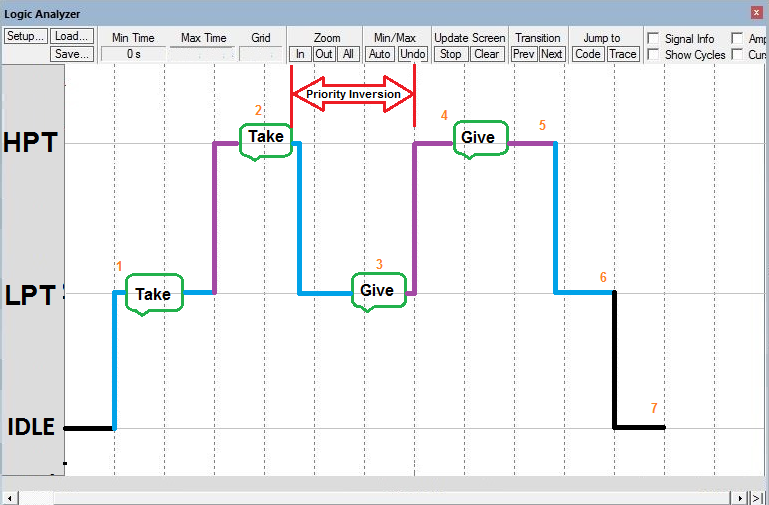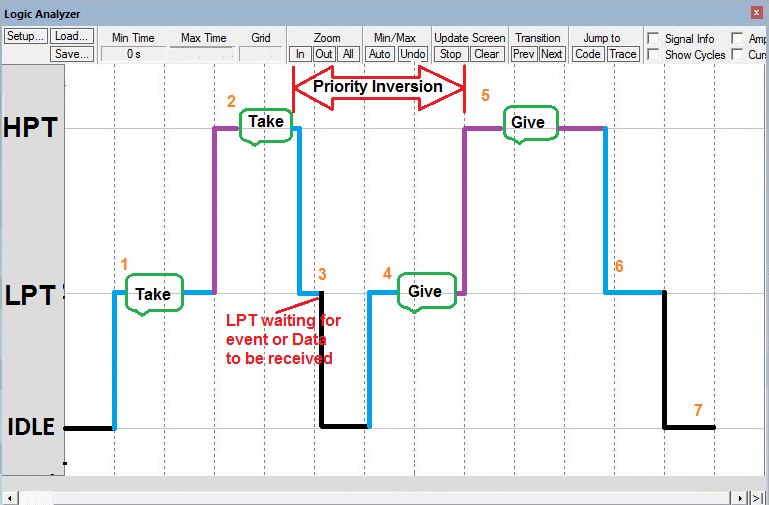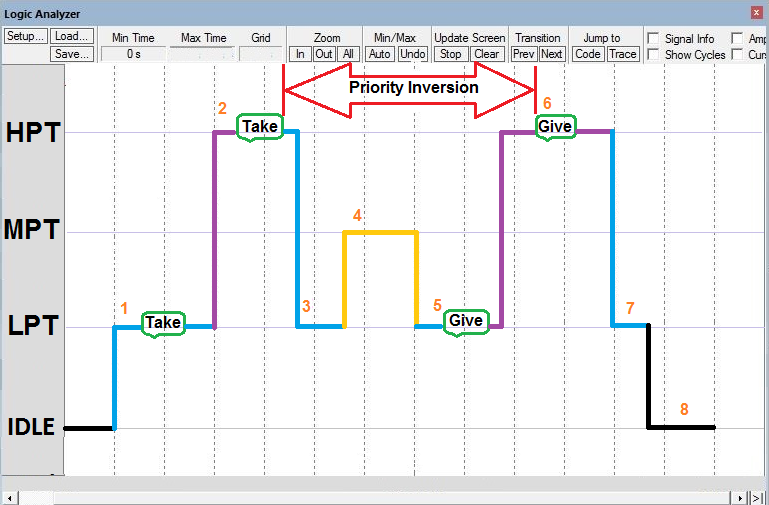Difference between revisions of "Read Task Info : vTaskList()"
| Line 45: | Line 45: | ||
This is a scenario where the HPT waits for the LPT as it is using the resource required by HPT.<br> | This is a scenario where the HPT waits for the LPT as it is using the resource required by HPT.<br> | ||
Let's see 3 different scenarios of priority inversion depending on the amount of time HPT waits for the lower priority tasks. | Let's see 3 different scenarios of priority inversion depending on the amount of time HPT waits for the lower priority tasks. | ||
| − | *<b>Normal Priority Inversion:</b> | + | *<b>Normal Priority Inversion:</b> Here an HPT tasks waits for the LPT tasks as it is holding the resource(semaphore). |
| − | Here an HPT tasks waits for the LPT tasks as it is holding the resource(semaphore). | + | |
#LPT starts running and acquires the semaphore. | #LPT starts running and acquires the semaphore. | ||
#Now HPT is created and it preempts LPT and starts running. It makes the request to acquire the semaphore. Since the semaphore is already with LPT, HPT goes to blocked state. | #Now HPT is created and it preempts LPT and starts running. It makes the request to acquire the semaphore. Since the semaphore is already with LPT, HPT goes to blocked state. | ||
#LPT starts executing again and releases the semaphore. | #LPT starts executing again and releases the semaphore. | ||
| − | Immediately the HPT comes out of the blocked state and starts executing. It runs for some time and deletes itself. | + | #Immediately the HPT comes out of the blocked state and starts executing. It runs for some time and deletes itself. |
#Now control goes back to LPT which completes its job and deletes itself. | #Now control goes back to LPT which completes its job and deletes itself. | ||
#Finally the scheduler is left out with idle task and it keeps running. | #Finally the scheduler is left out with idle task and it keeps running. | ||
Revision as of 09:48, 14 July 2016
In this tutorial, we will be discussing a Semaphore and its types ie. Binary, Mutex, Counting.
Later we will see each semaphore in detail with its pros and cons.
Also, we will be looking into priority inversion and priority inheritance.
Contents
Teminologies
- LPT: Low Priority Task
- MPT: Medium Priority Task
- HPT: High Priority Task
What is a Semaphore?
Semaphore is a technique for synchronizing two/more task competing for the same resources. When a task wants to use a resource, it requests for the semaphore and will be allocated if the semaphore is available. If the semaphore is not available then the requesting task will go to blocked state till the semaphore becomes free.
Consider a situation where there are two persons who want to share a bike. At one time only one person can use the bike. The one who has the bike key will get the chance to use it. And when this person gives the key to the 2nd person, then the 2nd person can use the bike.
Semaphore is just like this Key and the bike is the shared resource.
Whenever a task wants access to the shared resource, it must acquire the semaphore first.
The task should release the semaphore after it is done with the shared resource.
Until this time all other tasks have to wait if they need access to shared resource as semaphore is not available.
Even if the task trying to acquire the semaphore is of higher priority than the task acquiring the semaphore,
it will be in the wait state until the semaphore is released by the lower priority task.
Types of Semaphores
There are 3-types of semaphores namely Binary, Counting and Mutex semaphore.
- Binary Semaphore: Binary semaphore is used when there is only one shared resource.
Binary semaphore exists in two states ie.Acquired(Take), Released(Give). Binary semaphores have no ownership and can be released by any task or ISR regardless of who performed the last take operation. Because of this binary semaphores are often used to synchronize tasks with external events implemented as ISRs, for example waiting for a packet from a network or waiting for a button is pressed.
Because there is no ownership concept a binary semaphore object can be created to be either in the “taken” or “not taken” state initially.
Cons:
- Priority Inversion : HPT needs to wait for the LPT as LPT is holding the resource required for HPT. In between if MPT task comes then LPT will be in blocked state thereby delaying HPT.
- Does not support recursion : If a task tries to take the semaphore twice then it gets blocked and will not come out of that state till someone releases that semaphore.
- No ownership : Anyone can release or delete the semaphore because of which the dependent tasks will always be in the blocked state.
- Counting Semaphore: To handle more than one shared resource of the same type, counting semaphore is used. Counting semaphore will be initialized with the count(N) and it will allocate the resource as long as count becomes zero after which the requesting task will enter blocked state.
- Mutex Semaphore: Mutex is very much similar to binary semaphore and takes care of priority inversion, ownership, and recursion.
Priority Inversion
This is a scenario where the HPT waits for the LPT as it is using the resource required by HPT.
Let's see 3 different scenarios of priority inversion depending on the amount of time HPT waits for the lower priority tasks.
- Normal Priority Inversion: Here an HPT tasks waits for the LPT tasks as it is holding the resource(semaphore).
- LPT starts running and acquires the semaphore.
- Now HPT is created and it preempts LPT and starts running. It makes the request to acquire the semaphore. Since the semaphore is already with LPT, HPT goes to blocked state.
- LPT starts executing again and releases the semaphore.
- Immediately the HPT comes out of the blocked state and starts executing. It runs for some time and deletes itself.
- Now control goes back to LPT which completes its job and deletes itself.
- Finally the scheduler is left out with idle task and it keeps running.
In this scenario the HPT tasks waits for LPT from 2-4 which is the priority inversion period.

- Extended Priority Inversion:
- Worst Case Priority Inversion:


